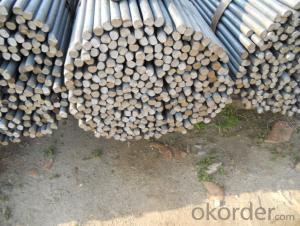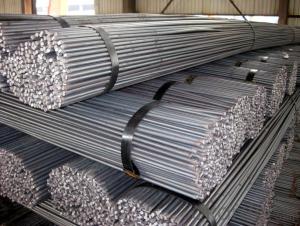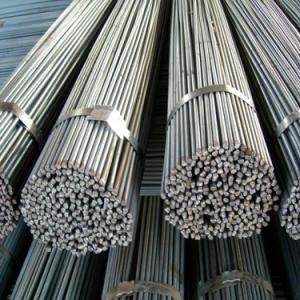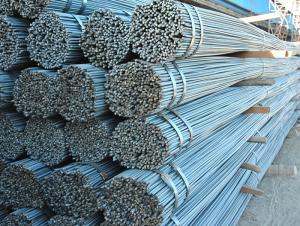alloy round steel bar JIS /GB/DIN STANDAR
- Loading Port:
- Shanghai
- Payment Terms:
- TT OR LC
- Min Order Qty:
- 100 m.t.
- Supply Capability:
- 100000 m.t./month
OKorder Service Pledge
OKorder Financial Service
You Might Also Like
Product Description:
Specifications of Hot Rolled Round Bar
1. Grade: Q235, SS400, A36, S235JR
2. Diameter: 6mm—150mm
3. Length: As customer’s request, but we usually produce 6m, 9m and 12m
4. Steel Grade: Mild carbon steel
5. Characteristics: Has a good harden ability, high hardness, wear resistance, heat distortion, etc. So it can be used in the production of heavy duty and complex shape mold.
6. Main Markets: Mid East, Southeast Asia, Africa, Oceania, Eastern Asia, Central America and South America, etc.
Usage and Applications of Hot Rolled Round Bar
1. Hot rolled round bar of 6-25mm, or small round is mostly used for straight bundles supply, and used for steel, bolts and various mechanical parts. While the bigger round bar, or more than 25mm hot rolled bar, is mainly for the manufacture of mechanical parts or for seamless steel billet.
2. Besides, we can supply some especial material steel round bar that can be used for main shaft of steamer, hummer shank, with big section and supper force.
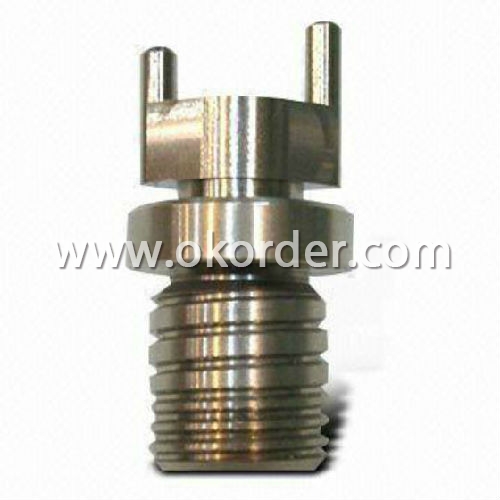
Packaging & Delivery of Hot Rolled Round Bar
Packaging Detail: All goods are packed in bundle with steel strips and shipped by break bulk vessel or container (depend on target market and different ports)
Delivery Detail: 45 days
Trade terms: FOB, CFR, CIF
MOQ: 25 tons per specification; we can negotiate the quantity if the specification is normal or we have stock of one specification.
Weight: The price invoicing on theoretical weight basis or actual weight basis depends on customer’s request.
Shipment: The shipment of bulk break or container is depends on customer’s request and the situation of the port of destination.
Documents given: Full set of original clean on board bill of lading; Original signed commercial invoice; Original packing list; Policy of insurance; Certificate of origin and what the target market needs.
Production Flow of Hot Rolled Round Bar
We use advanced equipments like Electric Arc Furnace, Ladle Furnace and Vacuum Degasser to produce our products.
The common processes are preheated forging quenching, dual refinement solution process, cooling quenching and isothermal quenching. We use heat treatment for dual refinement solution process. The main measures process is high temperature solution and refinement cycle. High temperature solution can improve the carbide morphology and particle size. The aim is to make the loop refinement ultrafine austenite grains.
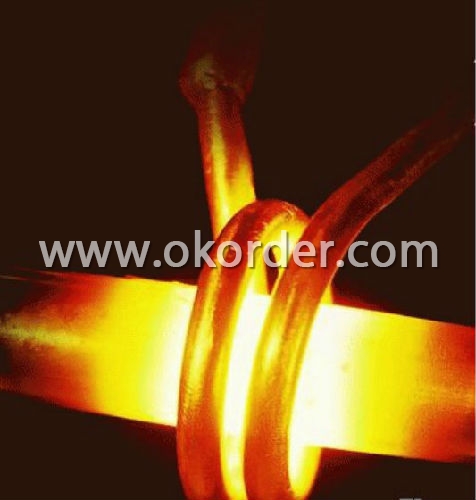
Quality Assurance of Hot Rolled Round Bar
1. We will strictly inspect our production that we sold according to the customer’s request.
2. Quality should be in conformity with the specification of the manufacturer. Quantity and packing conditions should be in conformity with the term in the contract.
3. Should the packing found damaged, the buyer has the right to claim to the seller.
- Q:Can steel round bars be used in the production of industrial machinery?
- Yes, steel round bars can be used in the production of industrial machinery. Steel round bars are commonly used in the manufacturing of machine components such as shafts, axles, gears, and fasteners due to their high strength, durability, and versatility. They provide excellent structural support and can withstand heavy loads and stress, making them ideal for use in various industrial machinery applications.
- Q:Can steel round bars be used for making medical equipment?
- Medical equipment can indeed be made using steel round bars. Steel is a versatile and durable material that is commonly used in the manufacturing of medical instruments and equipment. It possesses excellent strength and can withstand high levels of stress and pressure, making it suitable for a wide range of medical applications. Moreover, steel's resistance to corrosion and its ability to be easily sterilized ensure that the medical equipment remains hygienic and safe for use. Steel round bars can be machined, shaped, and formed into various medical instruments such as surgical tools, implants, braces, and prosthetics. Therefore, steel round bars are a viable option for producing medical equipment due to their strength, durability, and compatibility with sterilization processes.
- Q:Can steel round bars be used in the manufacturing of lighting fixtures?
- Yes, steel round bars can be used in the manufacturing of lighting fixtures. Steel is a versatile and durable material that can provide structural support and aesthetic appeal to lighting fixtures. Steel round bars can be fashioned into various shapes and sizes to create different components of lighting fixtures, such as frames, bases, or decorative elements. Additionally, steel can be easily manipulated through welding, bending, or machining processes to meet specific design requirements. It is also worth noting that steel has excellent corrosion resistance properties, ensuring that lighting fixtures made from steel round bars can withstand harsh environments and have a longer lifespan. Overall, steel round bars are a popular choice in the manufacturing of lighting fixtures due to their strength, versatility, and ability to enhance the overall design aesthetic.
- Q:Can steel round bars be used in the manufacturing of valves?
- Valves can indeed be manufactured using steel round bars. The utilization of steel round bars in valve production is widespread owing to their remarkable attributes of strength, durability, and resistance to corrosion. These round bars can be skillfully machined and forged into diverse valve components, including stems, bodies, and discs. Furthermore, steel round bars offer exceptional mechanical properties, thereby guaranteeing the ability of valves to endure extreme pressure and temperature conditions. Another advantage is that steel round bars can be effortlessly welded or threaded to connect different valve parts. In conclusion, steel round bars emerge as a dependable and highly favored material option for the manufacturing of valves.
- Q:How do steel round bars perform in high-temperature environments?
- Steel round bars generally perform well in high-temperature environments due to their high heat resistance and thermal stability. The composition and manufacturing process of steel bars allow them to retain their mechanical properties, such as strength and hardness, even at elevated temperatures. However, the specific performance of steel round bars in high-temperature environments can vary depending on factors like the grade of steel, duration of exposure, and the presence of corrosive agents.
- Q:How are steel round bars measured and specified?
- The diameter is utilized to measure and specify steel round bars. Typically, the diameter of a round bar is measured in millimeters or inches. The measurement is taken at the widest point of the circular cross-section. When it comes to specification, steel round bars are commonly specified by their diameter and length. For instance, a steel round bar can be specified as "25mm diameter x 3 meters length". This indicates that the bar has a diameter of 25mm and a length of 3 meters. Moreover, steel round bars can also be specified based on their tolerance, surface finish, and grade. Tolerance refers to the allowable deviation from the specified diameter. Surface finish pertains to the quality of the bar's surface, which can vary from rough to smooth. Grade signifies the quality and composition of the steel utilized to produce the round bar, such as mild steel, carbon steel, or alloy steel. Accurate measurement and specification of steel round bars are crucial to ensure that they meet the necessary dimensions and properties for a specific application.
- Q:Can steel round bars be used for making electrical components?
- Whether steel round bars can be used for making certain electrical components depends on the specific requirements and applications. Steel is a versatile material that possesses good electrical conductivity and high durability, making it well-suited for a variety of electrical applications. However, when it comes to components that necessitate specific electrical properties or insulation, copper or aluminum may be more commonly utilized. Furthermore, in order to prevent corrosion or enhance electrical conductivity, it may be necessary to subject steel round bars to surface treatments or coatings. Ultimately, the appropriateness of utilizing steel round bars for manufacturing electrical components should be evaluated in accordance with the specific requirements and regulations of the intended application.
- Q:What are the advantages of using lead-alloy steel round bars?
- Using lead-alloy steel round bars has numerous advantages: 1. Enhanced machinability: The presence of lead in the alloy greatly improves the machinability of the round bars. By acting as a lubricant during machining processes, lead reduces friction and heat generation. This results in longer tool life and superior surface finish for the machined components. 2. Superior wear resistance: Lead-alloy steel round bars possess exceptional wear resistance, making them ideal for applications involving abrasive conditions or frequent contact with other surfaces. The inclusion of lead in the alloy helps minimize wear and tear, thereby prolonging the lifespan of the round bars. 3. Improved thermal conductivity: Compared to regular steel, lead has higher thermal conductivity. As a result, lead-alloy steel round bars exhibit superior heat dissipation properties, making them suitable for applications that involve high temperatures. This characteristic effectively prevents overheating and potential damage to the material. 4. Reduced vibration and noise: The presence of lead in the alloy aids in dampening vibrations and reducing noise levels. This is particularly advantageous in applications where noise reduction is crucial, such as in construction equipment or automotive components. 5. Easy machinability of leaded zones: Selective machining of lead-alloy steel round bars allows the creation of leaded zones. These zones effectively act as self-lubricating areas, reducing friction and wear between moving parts. This feature proves highly beneficial in applications where frequent lubrication is impractical or unfeasible. 6. Cost-effective solution: Lead-alloy steel round bars provide a cost-effective solution for various industries. By enhancing performance and durability without significantly increasing the overall cost, the inclusion of lead in the alloy makes these round bars a popular choice for many applications.
- Q:What is the difference between hot rolled and cold rolled steel round bars?
- Hot rolled and cold rolled steel round bars differ in their production process and resulting characteristics. Hot rolled steel round bars are made by heating billets or ingots to a high temperature and then shaping them into the desired form using rolling mills. This process results in a scaled surface and a relatively rough texture. Hot rolled steel round bars have a wider tolerance and are not as precise in terms of their dimensions. They are generally used in applications where precision is not critical, such as construction and general manufacturing. On the other hand, cold rolled steel round bars are manufactured by cooling down hot rolled steel to room temperature and then further processing it through cold rolling mills. This process results in a smoother surface and a more precise dimension. Cold rolled steel round bars have a tighter tolerance and are commonly used in applications where precision is crucial, such as automotive components, machinery parts, and tools. In terms of mechanical properties, hot rolled steel round bars generally have a lower tensile strength and yield strength compared to cold rolled steel round bars. Cold rolled steel also tends to have a higher hardness and a more uniform grain structure, which can enhance its strength and durability. Overall, the main difference between hot rolled and cold rolled steel round bars lies in their production process, surface finish, dimensional accuracy, and mechanical properties. The choice between the two depends on the specific requirements of the application and the desired characteristics of the end product.
- Q:What are the chemical composition requirements for steel round bars?
- The chemical composition requirements for steel round bars generally include a specific range of elements such as carbon, manganese, phosphorus, sulfur, silicon, and sometimes additional elements like chromium, nickel, and molybdenum. These requirements are defined by various international standards and specifications, ensuring the desired mechanical properties and performance of the steel.
1. Manufacturer Overview |
|
|---|---|
| Location | |
| Year Established | |
| Annual Output Value | |
| Main Markets | |
| Company Certifications | |
2. Manufacturer Certificates |
|
|---|---|
| a) Certification Name | |
| Range | |
| Reference | |
| Validity Period | |
3. Manufacturer Capability |
|
|---|---|
| a)Trade Capacity | |
| Nearest Port | |
| Export Percentage | |
| No.of Employees in Trade Department | |
| Language Spoken: | |
| b)Factory Information | |
| Factory Size: | |
| No. of Production Lines | |
| Contract Manufacturing | |
| Product Price Range | |
Send your message to us
alloy round steel bar JIS /GB/DIN STANDAR
- Loading Port:
- Shanghai
- Payment Terms:
- TT OR LC
- Min Order Qty:
- 100 m.t.
- Supply Capability:
- 100000 m.t./month
OKorder Service Pledge
OKorder Financial Service
Similar products
New products
Hot products
Related keywords
